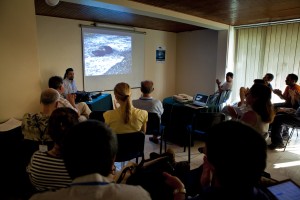Giuseppe Notarbartolo di Sciara, Tethys Research Institute, Milano

A workshop on monk seal conservation issues was organised within the framework of the second International Conference on Marine Mammal Protected Areas, held in Martinique from 7-11 November 2011. Nine experts on both extant monk seal species, from eight countries, contributed to the workshop, which I had the honour of coordinating.
The purpose of this workshop was to gather updated information on the status of both the Hawaiian and Mediterranean monk seals within their respective ranges, but in particular to explore ways in which marine protected areas (MPAs) can be used to protect these critically endangered mammals. The conditions under which monk seals survive vary greatly not only between Hawaii and the Mediterranean/North Atlantic, but also in the different localities within each species’ range. Accordingly, the tools to address the different pressures affecting monk seal status include, but are not limited to, the establishment of protected areas, and the application of these tools varies greatly between programmes.
Each programme shared its collective experience on the development and implementation of MPAs for monk seal conservation. All programmes agreed on the importance of MPAs but each group had different visions of their application. Greek presenters (Eleni Tryfon and Vangelis Paravas) believed that MPAs were important but greater ‘horizontal’ measures were essential to make recovery efforts more effective. The combined conservation value provided by MPAs and rehabilitation actions was emphasized (Lenie ‘t Hart). Programmes working on the Atlantic populations such as Madeira (Rosa Pires) and Saharan coast (Pablo Fernandez de Larrinoa and Hamady Ould Mohamed) had extremely positive results with the implementation and enforcement of regulations of marine and coastal protected areas. These programmes highlighted very successful inclusion of local communities as well as increases in local monk seal populations. In Turkey (Cem Orkun Kiraç), the experience has been that marine protected areas will not function effectively without integrated coastal and marine management planning. In general, coastal habitat destruction is the actual primary threat to the survival of the species and management and protection of the diverse PAs is insufficient, although there are successful examples of PA management practices in the country. Finally, the bulk of the Hawaiian monk seal population and their habitat in the NWHI (Charles Littnan) has been protected by the establishment of the Papahānaumokuākea Marine National Monument, but there are concerns that the system created to manage this area may obstruct critical enhancement activities in the future. The recently established population of seals in the Main Hawaiian Islands benefits from MPAs that have been established for other reasons; however, some concern was expressed about potential negative consequences of establishing any protected areas specifically for the species.
Despite great differences in population trends, threats, and conservation strategies across the genus, participants identified three shared issues of concern for their efforts to recover monk seals. First, actively engaging local communities is critical for each projects’ success and is essential to achieve long-term recovery goals (Giuseppe Notarbartolo di Sciara). Only by understanding communities’ needs, finding shared goals, and identifying creative solutions, can we create the culture of coexistence necessary to ensure the persistence of these species.
The second and third issues are closely linked and, at times, difficult to separate. Increased and sustained funding and greater action and support by government agencies are essential to complete the numerous ongoing and planned initiatives to protect habitats, increase seal survival, and build partnerships with key stakeholders. A number of ideas were shared on how to potentially influence government action and funding. While the group did not reach a consensus on a particular strategy, it was acknowledged that it would require efforts on both international and local scales and would vary based on the needs of the individual programmes. In particular, as far as Mediterranean monk seal conservation is concerned, the Workshop noted that many recommendations had been formulated and adopted at a large number of monk seal conservation meetings organized during the past two decades. Therefore it was felt that, rather than adding new recommendations to the list, what was most needed was creating mechanisms whereby governments are urged and supported to implement conservation actions that they have already committed to.
